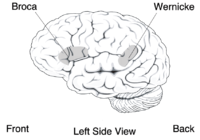
Photo from wikipedia
This study aimed to examine predictors of language functioning in a sample of pediatric patients diagnosed with anti-N-methyl-D-aspartate receptor encephalitis (ANMDARE). Patient data was collected through retrospective chart review within… Click to show full abstract
This study aimed to examine predictors of language functioning in a sample of pediatric patients diagnosed with anti-N-methyl-D-aspartate receptor encephalitis (ANMDARE). Patient data was collected through retrospective chart review within a children’s hospital. Pediatric patients (N=16) treated for ANMDARE (12% male; 25% Caucasian, 50% African American, 25% Latino, mean age = 12.3) who completed a neuropsychological evaluation were identified (time since diagnosis M = 177.4;SD = 310.2). Language assessments included Wechsler Abbreviated Scale of Intelligence-II (WASI-II) Vocabulary; Wide Range Achievement Test- 4 (WRAT-4) Word Reading; Delis-Kaplan Executive Function System (D-KEFS) Verbal Fluency. Two independent-samples t-tests compared language functioning in patients with normal and abnormal MRI findings. Significant differences were found in vocabulary scores between patients with normal (M = 45.57, SD = 5.50) and abnormal MRIs (M = 36.67, SD = 5.35;t(11) = 2.94,p = 0.013). The magnitude of the differences in means (μd = 8.91,95%CI:2.25-15.56) was medium (η2 = 0.44). A significant difference in semantic fluency scores were also found (Normal MRI; M = 10.67, SD = 2.25 vs abnormal MRI; M = 6.13;SD = 1.23; t(12) = 3.89,p = 0.002). The magnitude of the differences in means (μd = 4.54, 95%CI:2.00- 7.09) was medium (η2 = 0.56). Additional analyses revealed a relationship between seizure presentation and vocabulary scores (t(11) = 2.50;p = 0.029). Pediatric patients with abnormal MRIs demonstrate greater deficits in vocabulary and semantic fluency compared to those with normal MRIs. Moreover, patients who presented with seizures were more likely to have deficits in vocabulary. Previous research shows variability in prolonged deficits in language functioning in both children and adults. To the best of our knowledge, this is the first study to compare symptom presentation with language outcomes, thus potentially contributing to the clinical utility of MRI scans.
Journal Title: Archives of Clinical Neuropsychology
Year Published: 2019
Link to full text (if available)
Share on Social Media: Sign Up to like & get
recommendations!